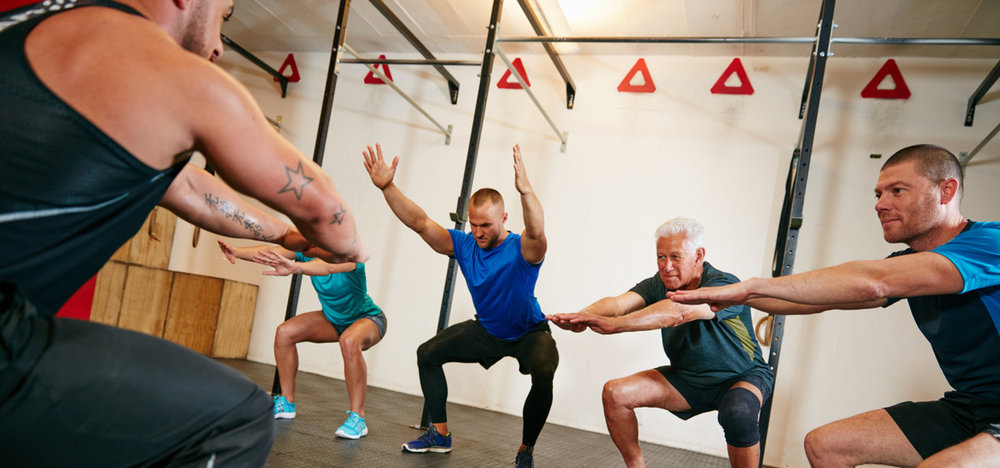
Called crepitus, the crackling alone won’t hurt you. But it could signal serious knee issues to come.
You’re halfway into a squat or lunge, and your knees start spazzing out. They crack, pop and pretty much create their own less-than-pleasant workout soundtrack.
Called crepitus, this crackling can freak out anyone who doesn’t want to destroy his or her knees, or perhaps has some existing knee issues like runner’s knee, IT Band syndrome or osteoarthritis to contend with.
What’s That Sound?
Crepitus can be totally benign and is very similar to popping your knuckles or back. During exercises like squats and lunges, the force on your knee joint can squish any gas that’s hanging out in the synovial fluid surrounding your knee (synovial fluid works to protect and lubricate your joints), causing a popping sensation or maybe even an audible “crack,” explains Minnesota-based exercise physiologist and certified strength and conditioning specialist Mike T. Nelson.
While it can be unnerving if you don’t know what it is, this form of crepitus is generally not painful or harmful. It’s common in people of all ages, and a 2013 Clinical Orthopaedics and Related Research study determined that, even in patients who experience crepitus after undergoing knee surgery, pain-free popping isn’t cause for worry.
However, in many people, crepitus can actually be the sound of your joint structures grating against each other – and that’s a sign of serious knee problems to come, explains physical therapist and certified strength and conditioning specialist Tony D’Angelo, senior vice president of clinical operations for Professional Physical Therapy in New York.
“Cracking or ‘crepitus’ can develop from poor alignment of the knee cap, called the patella, within the groove formed by the bones of the knee joint,” D’Angelo says. “It results in the progressive wearing away of the protective cartilage within the joint. Over time, the wearing becomes worse, and when the soft cartilage is worn away enough, it becomes very painful and leads to an arthritic joint.”
In fact, 2014 research published in Osteoarthritis and Cartilage, the official journal of the Osteoarthritis Research Society International, determined that, when coupled with knee cap pain, crepitus is an early indication of patellofemoral joint (where your knee cap meets your thigh bone) lesions and future osteoarthritis in the area. Knee osteoarthritis, which affects about 13 percent of women and 10 percent of men age 60 and older, is one of the leading causes of disability in the U.S., according to a review of knee osteoarthritis published in the Caspian Journal of Internal Medicine.
How to Deal with the Crackling
If you experience pain along with crepitus, it’s important to stop what you are doing and seek medical attention from a qualified orthopedist, physical therapist or sports medicine physician, Nelson says. They can help determine exactly what’s going on within your knee joint as well as the best course of treatment, if needed. In cases of knee issues, crepitus is generally coupled with pain ranking as more than a 2 on a scale of 1 to 10, D’Angelo says. Discomfort can last even after you’ve left the gym and up to 24 hours or more, and often accompanies joint swelling, he says.
While there is no current research demonstrating that crepitus without pain is harmful, prioritizing proper exercise form as well as integrating knee-stabilizing exercises into your workout routine can help prevent misalignment of the knee cap and more serious causes of crepitus, such as osteoarthritis, down the road, D’Angelo says.
For improved knee function and health, he recommends strengthening the quadriceps (on the front of the thigh) and gluteal muscles (which make up your butt). These muscle groups help center the patella within its groove.
Interestingly, squats and lunges are great for strengthening those muscles. This highlights the need to always prioritize proper form, as even great exercises like these can contribute to knee wear and tear when not performed properly, D’Angelo says. During these exercises, focus on not letting your knee cave in toward your opposite leg or out to the side; your shin should always stay perpendicular to the floor. Similarly, if you commonly experience crepitus or slight discomfort when performing these exercises, you may need to work on sitting back into your butt, rather than dumping the weight forward into your knee, according to Nelson.
Within the gluteal muscles, the gluteus medius on the side of your hip is especially important in positioning and stabilizing your knee. “This muscle group is often very weak and extremely important when performing complex movements like squats and lunges,” D’Angelo says. To increase strength in the glute med, turn to hip abduction exercises like lateral band walks and clamshells.
Lastly, while the knee extension machine will strengthen your quads, this machine is best avoided, especially for those with existing knee problems, he says. “Loading your knee in this position is something that does not occur naturally. The knee extension places more stress on the undersurface of the kneecap. In turn, that further irritates the soft cartilage and worsens pain and poor tracking of the knee cap,” he says.
Written for Health.USnews.com